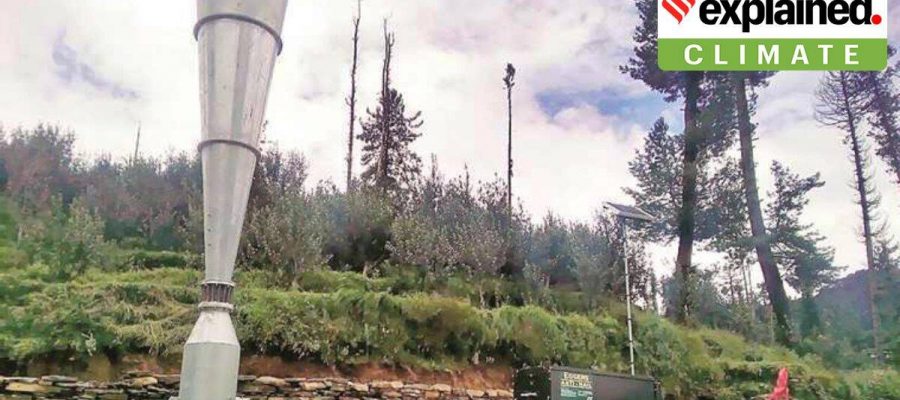An anti-hail gun is a machine which generates shock waves to disrupt the growth of hailstones in clouds, according to its makers. It comprises a tall, fixed structure somewhat resembling an inverted tower, several metres high, with a long and narrow cone opening towards the sky.
To help out horticulturists who face crop damage due to hailstorms, the Himachal Pradesh government will be testing the use of indigenously developed ‘anti-hail guns’. State Horticulture Minister Mahender Singh Thakur had said on Tuesday that ‘anti-hail guns’ developed in India will be installed in some areas on a trial basis.
What are anti-hail guns and how do they ‘prevent’ a hailstorm?
An anti-hail gun is a machine which generates shock waves to disrupt the growth of hailstones in clouds, according to its makers. It comprises a tall, fixed structure somewhat resembling an inverted tower, several metres high, with a long and narrow cone opening towards the sky. The gun is “fired” by feeding an explosive mixture of acetylene gas and air into its lower chamber, which releases a shock wave (waves which travel faster than the speed of sound, such as those produced by supersonic aircraft). These shock waves supposedly stop water droplets in clouds from turning into hailstones, so that they fall simply as raindrops.
Newsletter | Click to get the day’s best explainers in your inbox
According to the United Kingdom Meteorological Office, hail is produced by cumulonimbus clouds, which are generally large and dark and may cause thunder and lightning. In such clouds, winds can blow up the water droplets to heights where they freeze into ice. The frozen droplets begin to fall but are soon pushed back up by the winds and more droplets freeze onto them, resulting in multiple layers of ice on the hailstones. This fall and rise is repeated several times, till the hailstones become too heavy and fall down.
It is this hail formation process that the shock waves from anti-hail guns try to disrupt in a radius of 500 metres, so that the water droplets fall down before they can be lifted by the updrafts. The machine is repeatedly fired every few seconds during an approaching thunderstorm.
However, the effectiveness of anti-hail guns has remained a contentious issue.
Have anti-hail guns been used before in Himachal?
In 2010, the state government had imported three anti-hail guns from the United States and installed them in three separate villages in the apple-growing belt of Shimla, where hailstorms in summer cause severe damage to the fruit every year.
Two of the machines are currently functional while the third one was rejected by local residents. State horticulture department officials, responsible for operating the machines, maintain that since the installation of the guns, hail has occurred very few times in the two villages of Deorighat and Braionghat.
A few years ago, residents of around five villages in Shimla imported similar guns from New Zealand on a collective basis, but these machines have reportedly not worked so well.
“Maybe it works, but we still see hail from time to time. Hailstorms occurred this year as well,” said Pramod Kumar, a resident of Ratnadi where a gun has been installed. “Perhaps the state government should take over the machine so that it is operated optimally and we can be spared the high costs of running it,” he added.
According to Dr S K Bhardwaj from the department of environmental sciences at the state horticulture university, who is involved in developing the latest domestic anti-hail guns, it is crucial to fire the guns at the correct time to get positive results. “The operator has to remain updated with the weather forecasts as well as nowcasts from weather observatories and radars. One also has to be able to correctly identify the hail-forming cumulonimbus clouds and fire the guns before hail can be formed in that area. Once hail is already formed in the clouds, the guns can do little to stop it,” he said.
How are the new guns different from the earlier ones?
For one, they are likely to be much cheaper. The three guns imported by the government had cost nearly Rs 3 crore, and also incur high operational costs.
The indigenous guns have been developed by IIT Bombay along with Dr Y S Parmar University of Horticulture and Forestry at Nauni (Solan).
According to Dr Bhardwaj, they are expected to cost much lesser and could possibly run on LPG instead of acetylene. “But we are still testing the guns. A machine has been installed at Kandaghat for trial and now we will be setting up more guns at various elevations to see if and how they work,” he said.
State Horticulture Minister Mahender Singh Thakur, in a review meeting on Tuesday, had directed officials to install the guns at 8 to 10 locations in the state for trials.
Why is hail a big issue in HP?
Every summer from March to May, frequent hailstorms in the fruit-growing areas of Himachal destroy apples, pears and other crops, causing massive losses to farmers. In some hail-prone areas such as Narkanda and Theog, the entire apple crop in an orchard may sometimes get destroyed during such storms.
The state government has subsidised anti-hail nets but even these can fail in the face of storms. This April, hail and snow accumulated over the nets in many parts of Shimla after days of extreme weather, causing the nets to break down and damage the apple trees, fruits and branches underneath.
Source: Read Full Article


